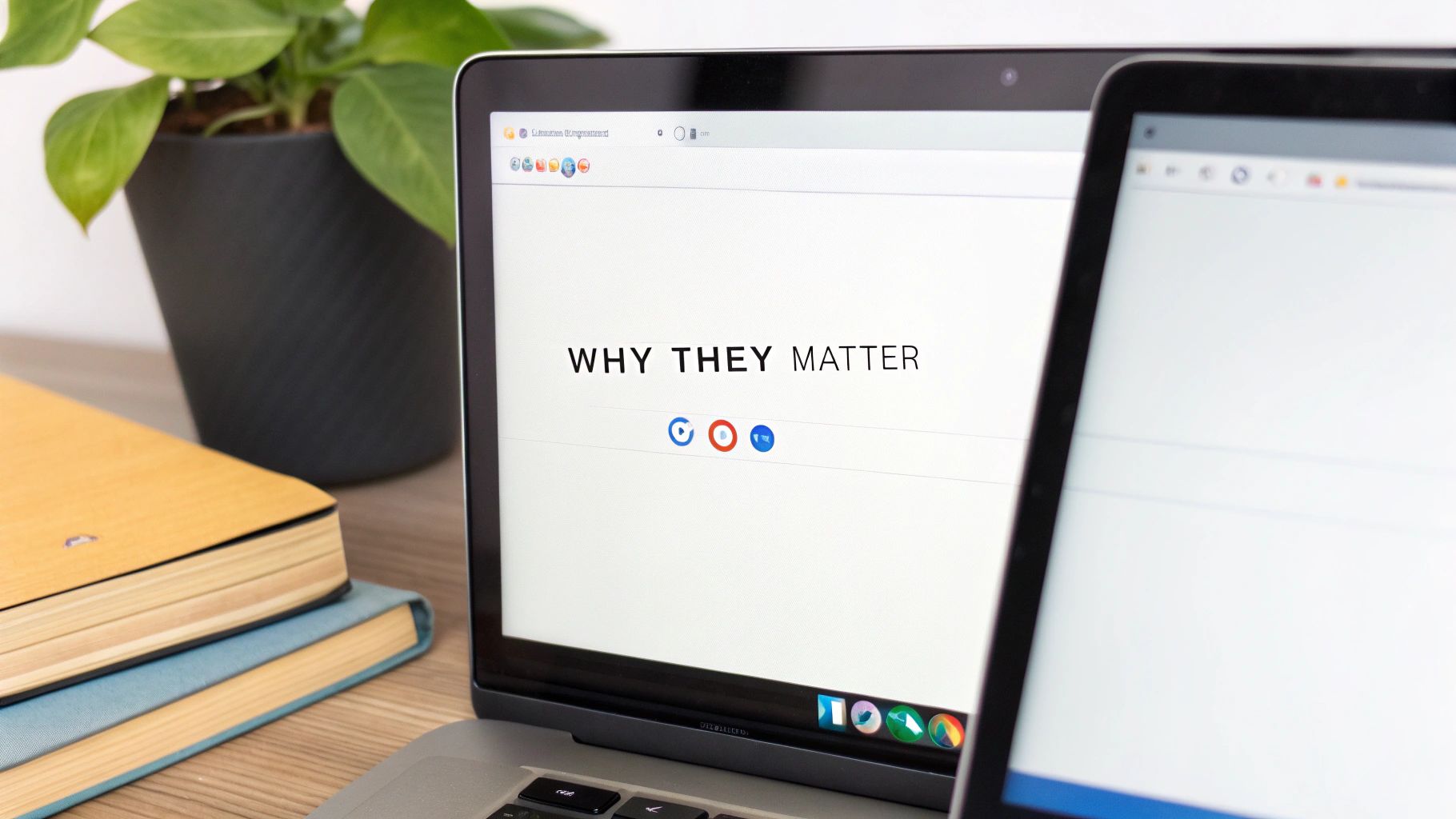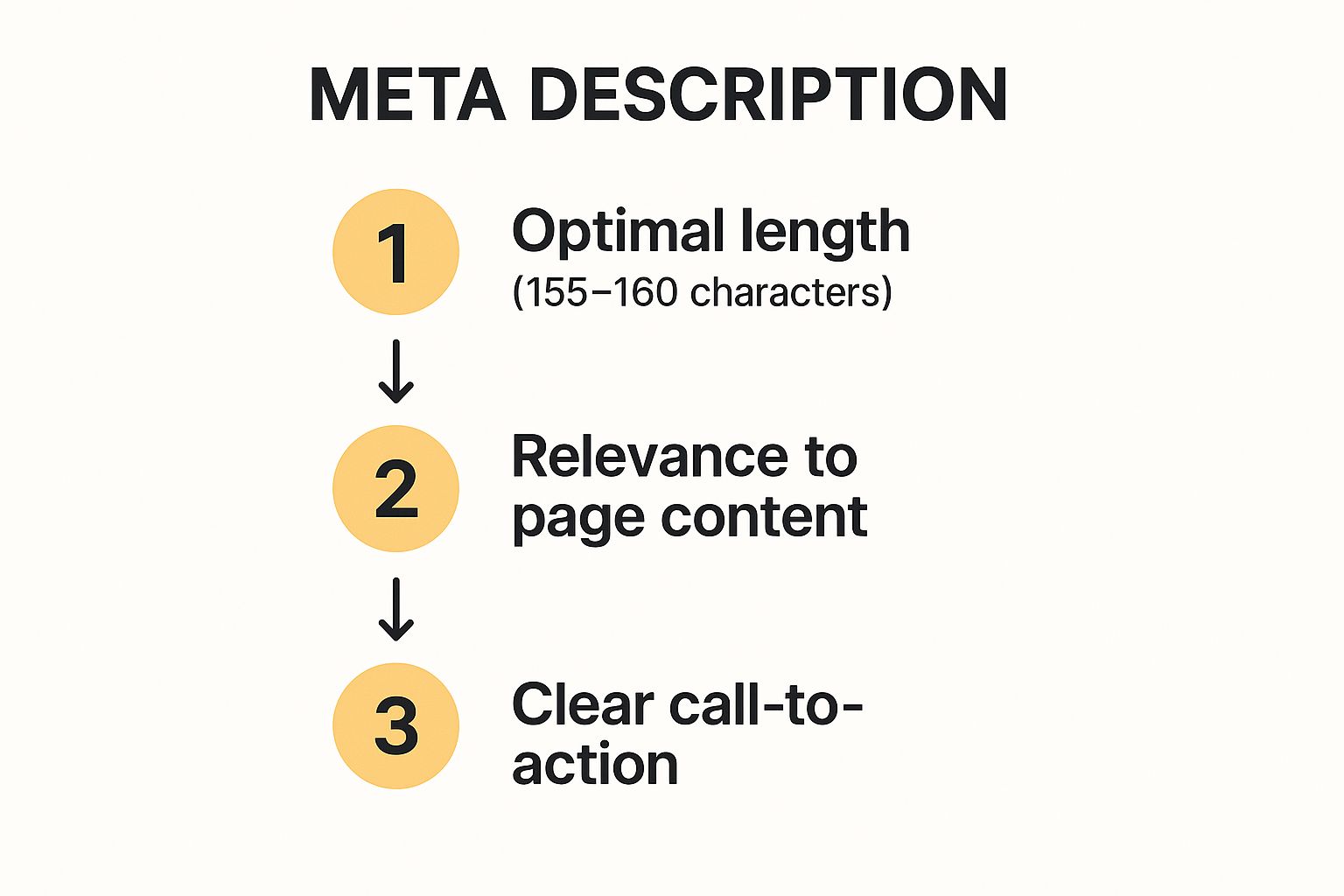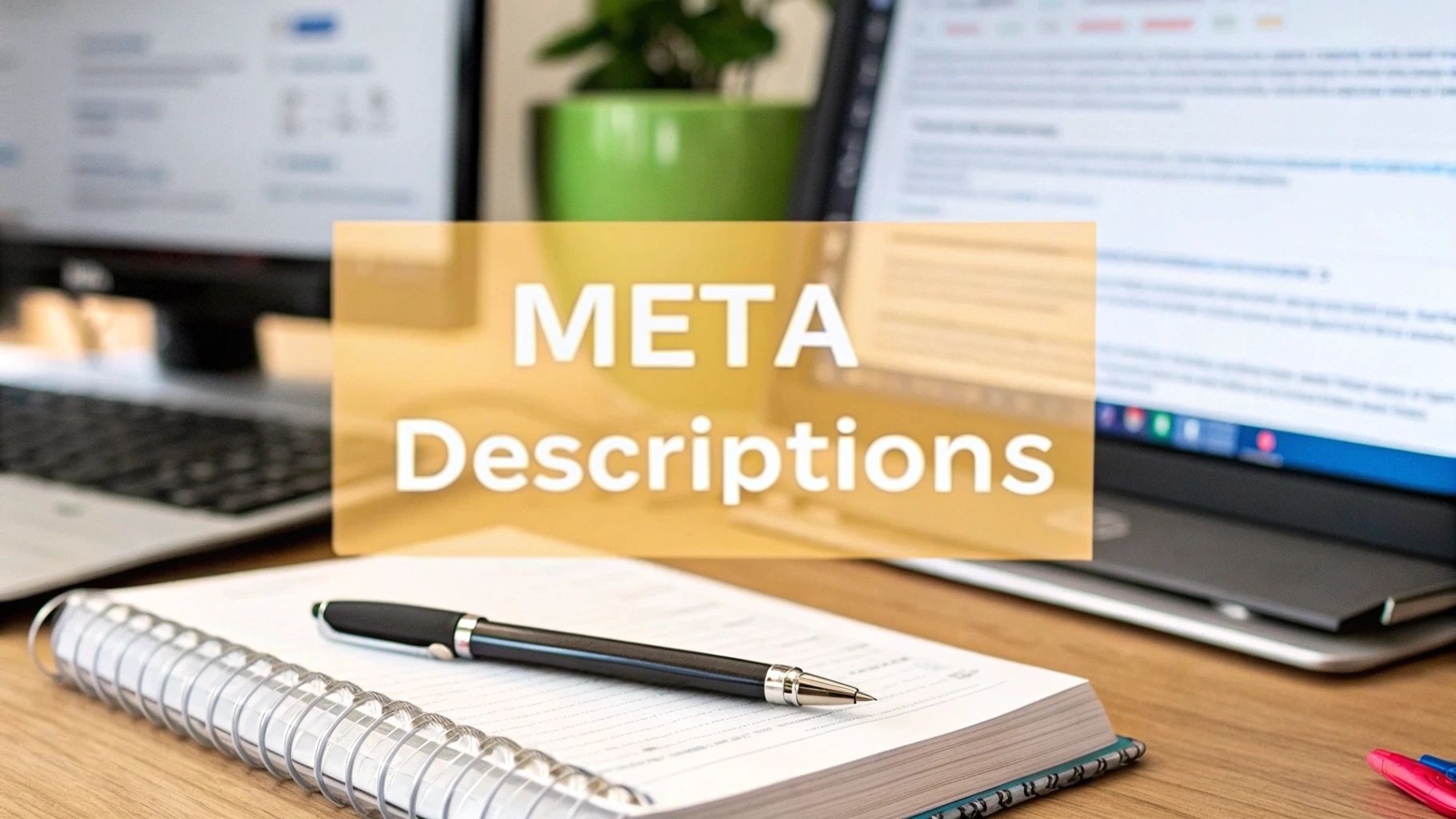Writing a meta description is your shot at writing a compelling ad for your page, right there on Google's results page. The goal is to summarize your content in about 155 characters, weave in a keyword, and use an active voice to convince someone to click your link instead of the one right above or below it.
Why Meta Descriptions Still Matter for Clicks
Let's clear up a common myth right away—meta descriptions are not a direct ranking factor. Google doesn't scan your description and decide to bump you up the rankings because of it.
So why do we spend so much time on them? Because they are a massive click-through factor.
Think of the search results page (the SERP) as a digital storefront. Your title tag is the sign above the door, but the meta description is the enticing window display that actually convinces people to come inside. It’s your first, and often only, chance to make a direct pitch to a potential visitor.
Your Digital Elevator Pitch
A well-crafted meta description is a short, powerful pitch. It bridges the gap between what someone just typed into Google and the solution your page offers. It basically tells a user, "Yep, this is exactly what you were looking for," before they've even landed on your site.
This simple snippet of text has a huge psychological impact, influencing whether a user chooses your result or just keeps on scrolling. To really get why this matters, it helps to have a solid handle on understanding the basics of Search Engine Optimization.
Here’s a perfect example of a search result with the title, URL, and the meta description highlighted so you can see it in action.

The highlighted text shows how the description adds valuable context that the title just can't squeeze in.
The Impact on Click-Through Rate
The link between a strong meta description and a higher click-through rate (CTR) isn't just theory; it’s something we see in the data all the time. It’s a direct line of communication with users, and a great one can give your traffic a serious boost.
In fact, a persuasive meta description that includes a clear call to action and a target keyword can improve CTR by 20-30% over a generic or missing one. That’s a lot of extra traffic for just a few minutes of work.
Your meta description is less about telling search engines what your page is about and more about telling people why they should care. It’s a marketing tool disguised as an SEO task.
At the end of the day, Google’s goal is to serve the best possible result. A higher CTR sends a strong signal to Google that users find your result more relevant and helpful than the others on the page. While it's not a direct ranking signal, a consistently high CTR can indirectly influence your search rankings over time. This makes mastering meta descriptions a critical part of any successful https://upnorthmedia.co/services/seo-marketing.
The Anatomy of a High-Performing Meta Description
Think of your meta description as a tiny, powerful billboard on the search results page. It's not just a summary of what's on the page; it's your one shot to convince a searcher that your link is the one they need to click. A great one is a blend of clarity and persuasion, all packed into a very small space.
At its core, every effective description has to answer one simple, unspoken question from the user: "Is this page exactly what I'm looking for?" Nailing this means striking a delicate balance between being informative and engaging.
Mastering the Core Components
Writing a description that actually gets clicks means focusing on a few critical elements. First off, you have to accurately reflect what's on the page. Nothing kills your credibility faster—or jacks up your bounce rate—than misleading someone into a click. A high bounce rate sends all the wrong signals to Google.
Next, you need to talk to your audience, not just at them. Ditching passive language for an active voice can make a world of difference. Instead of "Information can be found here," try "Discover how to..." It's a small shift, but it makes your result feel way more dynamic and actionable.
This handy visual breaks down the whole process.

As you can see, it's all about balancing length, relevance, and a clear call-to-action that tells the user what to do next.
Getting the Length Just Right
Length is a huge deal. You need enough space to be persuasive, but not so much that Google cuts you off mid-sentence. The sweet spot is between 140 to 160 characters. Go longer, and you risk your carefully crafted message getting truncated, which totally weakens its punch.
It's a small detail, but it's a massive opportunity. Nearly 25% of top search results don't even have a meta description. Just by writing a good one, you're already ahead of the game.
A powerful description also needs a clear call-to-action (CTA). This doesn't mean you have to be pushy. It can be as simple as:
- Learn more about...
- Get your free quote today.
- Shop the collection now.
- Read our complete guide.
This little nudge gives the user a clear next step and sets expectations for what they'll find when they land on your page.
Finally, you absolutely have to include your primary keyword. When a user's search query shows up in your meta description, Google often bolds it. This makes your result pop on the page and instantly reassures the searcher that your page is relevant. The trick is to work it in naturally, not stuff it in where it doesn't belong. Weaving these elements together is a key part of our SEO content writing tips.
To keep things straight, here's a quick cheat sheet.
Meta Description Do's and Don'ts
| Do | Don't |
|---|---|
| Keep it between 140-160 characters. | Exceed the character limit. |
| Include your primary keyword naturally. | Stuff keywords awkwardly. |
| Use an active, engaging voice. | Write in a passive, boring tone. |
| Add a clear call-to-action (CTA). | Leave the user guessing what to do next. |
| Accurately summarize the page content. | Write misleading or clickbait descriptions. |
| Write a unique description for every page. | Use the same description across multiple pages. |
Following these simple rules can make a massive difference in whether your link gets ignored or gets the click.
Remember, the goal isn't just to describe what's on the page. It's to communicate a clear benefit or solve a problem for the user, convincing them that your link is the best possible answer to their search.
Tailoring Descriptions for Different Page Types
A one-size-fits-all approach to meta descriptions is a recipe for missed opportunities. User intent changes drastically depending on whether they're searching for your brand, a specific product, or an answer to a question.
Writing the same style of description for your homepage and a blog post is like using the same script for a brand commercial and a product demo—it just doesn't work. Each page has a different job to do, and its meta description needs to reflect that.
Your homepage description is your digital handshake. It needs to establish authority, communicate your core value proposition, and almost always include your brand name. The goal here isn't to sell a single item but to sell your entire brand and convince the user you're a credible resource worth exploring. Think concise, confident, and encapsulating.

This approach ensures you capture those broad, brand-related searches effectively. You have to get inside the head of a user who is just getting to know you for the first time.
Crafting Descriptions for Product and Service Pages
When it comes to product or service pages, the focus has to shift from brand-building to benefit-driven persuasion. This is where you get specific and answer the user’s immediate need. Your goal is to drive a conversion, whether that’s a sale, a quote request, or a sign-up.
For these pages, your meta description should act like a mini sales pitch. What makes your product or service unique and valuable? Highlight it.
- For E-commerce: Mention key features like free shipping, a special offer, or a unique material. Include technical specs like model numbers or sizes if people are searching for them.
- For Services: Focus on the primary benefit or the pain point you solve. Use action-oriented language like "Get a free quote" or "Schedule your consultation today."
This direct approach helps pre-qualify the click. A user who clicks knows exactly what to expect, which usually leads to higher conversion rates and lower bounce rates. You're not just getting a click; you're getting a qualified click.
Writing Meta Descriptions for Blog Posts
Blog posts and articles require a completely different strategy. Here, your main goal is to spark curiosity and promise a valuable answer. You're not selling a product; you're selling information. The searcher is looking for knowledge, and your description must convince them you have the best answer on the SERP.
A great blog post description often teases the content without giving everything away. It might pose a question that the article answers or state a compelling fact that draws the reader in.
Think like a movie trailer. Your description should give a compelling preview of the content, highlighting the most interesting points and creating a sense of need-to-know that encourages a click.
For example, instead of a flat summary like, "This article is about how to write meta descriptions," try something more intriguing. "Unlock the secrets to writing meta descriptions that don't just summarize your content—they drive clicks. Learn the techniques that..."
This simple reframe changes the description from a boring summary into an enticing promise, making it far more effective at grabbing a searcher’s attention in a crowded results list.
Don't Make These Common Meta Description Mistakes
Even experienced writers can stumble into a few common traps when crafting meta descriptions. These slip-ups might seem small, but they can quietly tank your click-through rates and undermine all your hard work on the page itself.
The good news? They’re usually easy to spot and even easier to fix once you know what to look for.
The Problem with Duplicates and Keyword Stuffing
One of the most frequent mistakes I see is writing duplicate descriptions. This is when you get a little lazy (we’ve all been there) and use the same generic meta description across multiple pages. It feels like a time-saver, but it's a real killer in the search results.
When every page has the same summary, they all just blend together. You're giving searchers absolutely no reason to believe one of your pages is a better fit for their query than another.
Search engines pick up on this, too. While it's not a direct penalty, they see it as a low-effort signal. Honestly, if you're short on time, you're better off leaving the description blank. At least then Google will try to pull a relevant snippet from the page that matches the user's search.
Another classic error is keyword stuffing. This is an old-school, outdated tactic where you cram your target keyword into the description over and over, hoping to game the system.
Just look at this cringey example:
"Looking for the best running shoes? Our running shoes are the best shoes for running. Buy our running shoes today to improve your running."
It sounds completely robotic and spammy, doesn't it? This kind of writing repels clicks instead of attracting them. A much better approach is to use your main keyword once, maybe twice if it feels natural, within a sentence that actually offers some value.
Disconnected Content and Ignoring Your Audience
A third major pitfall is a disconnect between the description and the actual page content. Your meta description is a promise you make to the searcher. If you promise a "complete guide to SEO" but your page is just a short, three-paragraph blog post, you've broken that promise.
This mismatch leads directly to a high bounce rate. People will click, realize the page isn't what they were sold, and hit the back button immediately. That's a huge negative signal to Google, telling it your page isn't a good result for that query.
Your meta description and your page content have to be in perfect sync. Think of it as truth in advertising—you have to deliver exactly what you offer in the SERPs.
Finally, and this one happens more than you'd think, people write descriptions that are just plain boring or way too short.
A description like "Mechanical pencil" is technically accurate, but it gives a user zero reason to click. It fails to highlight any benefit, feature, or unique selling point. Always remember to write for humans first, focusing on what makes your page the absolute best answer to their search.
Writing Meta Descriptions in the Age of AI
The world of search is constantly shifting, and the old, rigid rules for writing meta descriptions are changing right along with it. It's no longer enough to just manually craft the perfect 155-character pitch and call it a day. Now, you need a strategy that works with the search engines' growing intelligence, not against it.
You've probably seen it yourself. You spend time writing a killer meta description, only to find Google showing something completely different in the search results. This isn't a bug; it's a feature. Google often rewrites descriptions to better fit a specific user's query, pulling what it thinks is the most relevant snippet directly from your page content.

This behavior gives us a massive clue about what search engines care about most: context and user intent. A single, static description can't possibly be the perfect answer for every variation of a search someone might type in.
Future-Proofing Your Descriptions
So, how do you write a meta description for a future where it might get rewritten anyway? You double down on clarity and focus on the benefits. Your main goal is still to write a compelling, human-first description, but your backup plan is to give search engines high-quality, well-structured content to pull from if they decide to go off-script.
This means focusing on a couple of key things:
- Clear, Benefit-Driven Copy: Make sure the actual content on your page is clear, concise, and packed with valuable information. This gives Google better raw material to work with when it creates its own snippets.
- Structured Data (Schema Markup): Using schema for products, articles, or FAQs gives search engines explicit context, helping them generate richer, more accurate descriptions on the fly.
Essentially, you're creating a Plan A (your own meta description) while providing all the ingredients for Google to cook up an effective Plan B. Search engines are leaning more on AI to tailor these snippets based on user context, location, and search history, a shift explored in recent findings about how AI is changing SERPs.
Instead of seeing a rewritten description as a failure, look at it as a data point. It's direct feedback from Google about what a specific searcher was really looking for. Use that insight to fine-tune both your on-page content and your future meta descriptions.
Using AI as Your Writing Assistant
This is where AI writing tools become a powerful ally—not a replacement. You shouldn't just ask an AI to "write a meta description" and blindly copy-paste the result. Instead, treat it like a smart assistant that can speed up your workflow.
I've found AI to be most useful for a few specific tasks:
- Brainstorming Angles: You can generate multiple variations of a description in seconds to see different ways of highlighting a page's benefits.
- Refining Tone: Ask it to rewrite a draft to sound more persuasive, more professional, or just more concise.
- Checking for Clarity: Use it to simplify complex sentences and make sure your core message is crystal clear.
This approach combines human strategy with AI efficiency. You stay in control of the core message and the user-focused strategy, while letting the technology handle some of the heavy lifting. This kind of balance is crucial for developing a strong AI SEO strategy that keeps you ahead of the curve.
Still Have Questions About Meta Descriptions?
Even with a solid game plan, a few questions always pop up when you're deep in the weeds of writing meta descriptions. I get it. This is where we’ll tackle some of the most common ones I hear.
Think of this as the troubleshooting section. We'll clear up the confusion around character counts, why Google sometimes goes rogue and rewrites your work, and how to handle a massive website without losing your mind.
How Much Does the Exact Character Count Really Matter?
Okay, let's be real: there isn't a single magic number that guarantees a click. But sticking to the recommended length is still incredibly important. The sweet spot is generally somewhere between 120 and 156 characters.
The real goal here isn’t to hit a specific number—it’s to avoid getting cut off. When your description gets the dreaded "..." at the end, your message feels incomplete and just looks unprofessional. It's always better to be a little short than a little too long.
Why Does Google Keep Rewriting My Meta Descriptions?
It’s definitely frustrating to spend time crafting the perfect description only to see Google ignore it. But trust me, it’s not a sign that you did something wrong. Google's one and only mission is to give the user the best possible answer for their specific search.
Sometimes, its algorithm decides that a small snippet of text from your actual page content is a better fit for a particular query than the description you wrote. This is exactly why your on-page copy needs to be just as sharp—it gives Google good alternative material to pull from.
A rewritten description is basically free user research. It shows you exactly what Google thinks is most relevant on your page for a certain search, which is a goldmine of insight into what your audience is actually looking for.
What Do I Do if I Have Hundreds (or Thousands) of Pages?
For a big site—especially e-commerce stores or anything database-driven—the idea of writing a unique meta description for every single page is enough to make you want to give up. This is where you have to get strategic and prioritize.
Start with the pages that move the needle:
- Your homepage
- Major category and service pages
- Your top-performing blog posts or articles
- Any high-value product pages
For everything else, you can often generate descriptions programmatically using data you already have. For instance, a product page description can be automatically built from the product name, brand, and a key feature or two. This is way, way better than leaving them blank or, even worse, using the same description everywhere.
The key is to make sure these auto-generated descriptions are still readable and unique. A simple template like "[Product Name] by [Brand] - Find specs, read reviews, and get free shipping" is a solid starting point. It's a practical way to manage meta descriptions at scale without sacrificing quality.
Ready to stop guessing and start growing? The team at Up North Media specializes in data-driven SEO strategies that deliver real results. From expert web development to targeted marketing, we build digital solutions that boost your revenue and visibility. Start your journey with a free consultation today.
